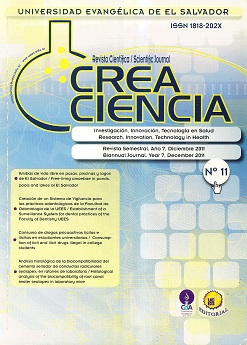Consumption of lawful and illegal psychoactive drugs in university students
DOI:
https://doi.org/10.5377/creaciencia.v0i11.8145Keywords:
Simultaneous consumption, drugs, psychoative substances, prevalenceAbstract
The objective of the study was to determine the consumption of licit and illegal psychoactive substances in university students.
It was carried out in 14 private universities in El Salvador, with a sample of 594 active university students, enrolled in the different careers that these universities serve, with a confidence level of 95% and a confidence interval of 4%, the sample was proportionally stratified according to the student population of each university.
The type of study was descriptive with a cross-sectional design.
It was found that the prevalence of drug use in the study was low for licit drugs and much lower for illicit drugs.
Alcohol and tobacco were the substances most consumed by the students and it was found that the consumption of drugs simultaneously is minimal.
The student mentioned being satisfied and very satisfied, which was reflected in his academic averages that turned out to be good and very good.
In the family aspect, relations with their parents were very good and good, where bad relations or non-relationship with their parents resulted in very low percentages.
Economically, the consumption of psychoactive substances has affected very little, this is related to the low consumption found in the study; Only in very few cases have you incurred actions such as lending money to friends, family members or anyone.
In actions that go against the legality, committed when the student was under the effects of psychoactive substances, there were cases of automobile accidents, calls for academic attention, problems with the police, fights that resulted in arrests, fines when driving in that state, imprisonment, being injured or injured by another person and being suspended from the university, all previous actions were presented in low percentages.
Downloads
822
Downloads
Published
How to Cite
Issue
Section
License
© Crea Ciencia
Declaration of originality and assignment of rights
The article must be sent with a declaration of originality, responsibility and assignment of rights of copy of the manuscript, scanned and signed by the author or by one of the authors when the authorship is collective (designated author), stating that the text has not previously published in printed or electronic format, which will not be presented to any other media before knowing the decision of the journal Crea Ciencia and that, if accepted for publication, the authors transfer the copyrights in all forms and media known. At the end of six months of the publication, the text can be shared in another magazine citing the first version of the article published in Crea Ciencia and recording its number and volume. If the article is not published, the UEES agrees to return the rights enunciated to their authors.

Crea Ciencia articles are published in open access and licensed under a Creative Commons Attribution-NonCommercial 4.0 International License.

